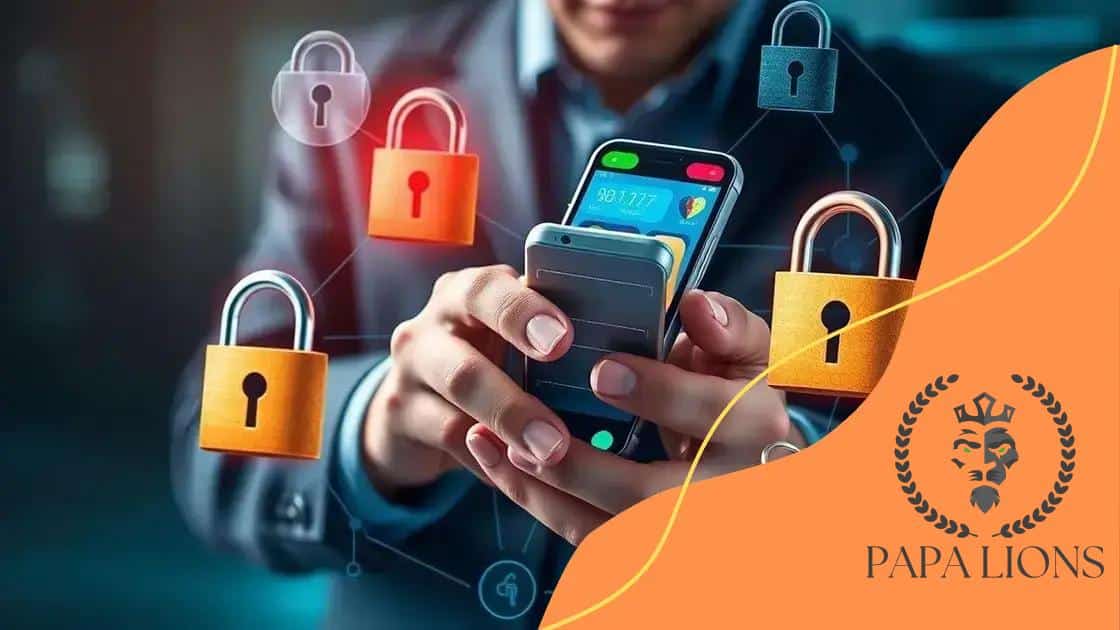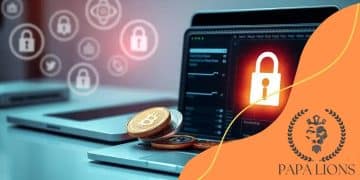Digital wallet security enhancements: protect your money now

Digital wallet security enhancements involve implementing strong passwords, enabling multi-factor authentication, and staying informed about potential vulnerabilities to protect financial information effectively.
Digital wallet security enhancements are essential in our technology-driven world. Have you ever considered how secure your digital transactions really are? Let’s dive into effective strategies that can help you stay protected.
Understanding digital wallets
Understanding digital wallets is vital in today’s cashless society. These tools allow users to store payment information securely on their devices, making transactions quicker and easier. But what exactly makes up a digital wallet?
What is a digital wallet?
A digital wallet is an electronic version of a physical wallet. It allows users to store credit card numbers, debit card numbers, and even some types of personal identification. Essentially, digital wallets function as virtual versions of traditional wallets, but with added benefits of convenience and security.
Key features of digital wallets
Digital wallets come with various features that make them appealing:
- Convenience: Easily access your funds without needing to carry cash or cards.
- Security: Many digital wallets use encryption and other security measures to keep information safe.
- Integration: Can be linked to loyalty programs, making it easier to collect rewards.
As more people switch to digital transactions, understanding how these wallets work becomes essential. They not only simplify purchases but also help track spending over time.
Moreover, digital wallets often include features like transaction history, which allows users to monitor their expenses. This functionality can encourage smarter financial decisions. Furthermore, many digital wallets support various payment methods and currencies, providing flexibility.
How digital wallets work
When you use a digital wallet, you’re utilizing a combination of technologies. The wallet is linked to your bank account or card. When making a purchase, the wallet communicates securely with the merchant’s payment system. This communication is encrypted, ensuring that your sensitive information remains protected.
In addition to security, digital wallets enhance the shopping experience by enabling contactless payments. With a simple tap of your smartphone, you can make purchases, making checkout fast and efficient.
Overall, understanding digital wallets is the first step towards leveraging modern financial tools. They offer safety, efficiency, and new ways to engage in commerce, which are more relevant than ever.
Common security vulnerabilities
Understanding common security vulnerabilities in digital wallets is crucial for users aiming to protect their financial information. Many individuals unknowingly expose their data, putting themselves at risk. Let’s explore various vulnerabilities that can compromise wallet security.
Phishing attacks
One of the most prevalent threats is phishing. In a phishing attack, hackers trick users into providing sensitive information, often through fake emails or websites. These fraudulent attempts can look genuine, making it essential for users to be vigilant.
- Always verify the sender’s email address.
- Check for spelling errors in URLs.
- Use multi-factor authentication whenever available.
Being cautious with emails and links can significantly reduce the risk of falling victim to phishing scams.
Weak passwords
Another vulnerability stems from weak or reused passwords. Many users tend to create simple passwords or use the same password across multiple platforms. This practice is dangerous, as it makes it easier for hackers to gain access to various accounts.
To enhance security, users should create strong, unique passwords for each of their digital profiles. Using a password manager can help generate and store complex passwords.
Open Wi-Fi networks pose additional threats when accessing digital wallets. Public networks often lack proper security measures, making it easy for cybercriminals to intercept data. It’s advisable to avoid using digital wallets on public Wi-Fi and, when necessary, to use a Virtual Private Network (VPN) for added protection.
Mobile device vulnerabilities
Mobile devices are also susceptible to vulnerabilities. If a user’s device is compromised, all stored information, including wallet data, can be at risk. Keeping software updated can help protect against known exploits and malware.
Installing apps only from official app stores is crucial. This practice reduces the risk of downloading malicious software that can jeopardize wallet security. Regularly reviewing app permissions can also help in identifying any unusual access requests.
Awareness of these common security vulnerabilities is essential for everyone using digital wallets. By implementing security measures and being cautious, users can protect their financial assets effectively.
Best practices for enhancing security

Implementing best practices for enhancing security in digital wallets is essential to keep your financial information safe. Many users are unaware of simple actions that can significantly boost their security.
Use strong, unique passwords
Creating strong and unique passwords is the first step. Avoid using easily guessed details like birthdays or pet names. Instead, opt for long passwords that combine letters, numbers, and symbols. Also, change passwords regularly to ensure continued protection.
Using a password manager can help in storing and generating complex passwords. This tool allows you to maintain unique passwords for different accounts without the hassle of remembering them all.
Enable multi-factor authentication (MFA)
Multi-factor authentication adds another security layer. With MFA, you must provide two or more verification factors to gain access to your digital wallet. This can include a text message code or a biometric scan.
- Set up MFA for all accounts linked to your wallet.
- Use authenticator apps instead of SMS for better security.
- Regularly update your MFA settings for maximum protection.
These steps make it significantly harder for hackers to gain unauthorized access.
Keep software updated
Regularly updating apps and operating systems is another critical security measure. Developers frequently release updates to fix vulnerabilities; therefore, keeping your software up to date is vital.
Enable automatic updates on your devices to ensure you always have the latest security features. This minor adjustment can prevent many potential threats.
Avoid public Wi-Fi
Using public Wi-Fi can expose your digital wallet to hackers. When connecting to these networks, avoid accessing sensitive information. If you must use public Wi-Fi, utilize a VPN to encrypt your internet connection.
Connecting through a VPN protects your data even on unsecured networks. This practice adds a necessary layer of security, ensuring that your financial information remains private.
By following these best practices for enhancing security, users can significantly reduce their risk of cyber threats and ensure safer digital transactions.
Choosing secure wallets
When it comes to choosing secure wallets, it’s important to understand what features to look for. Many digital wallets are available, but not all provide the same level of security. Knowing the right indicators of a safe wallet can keep your financial data secure.
Research wallet types
Start by researching different types of digital wallets. They generally fall into two categories: hot wallets and cold wallets. Hot wallets are connected to the internet, allowing for quick access and transactions. However, they are more vulnerable to hacking.
In contrast, cold wallets are offline and offer a higher level of security. They store your information on a physical device, making it difficult for online attackers to access. Consider your needs and decide which type fits your usage style best.
Look for strong encryption
Another key factor is the encryption used by the wallet. Strong encryption protects your data from unauthorized access. Always look for wallets that offer advanced encryption technologies, such as AES-256.
- Check the wallet’s website for security information.
- Read user reviews to learn about others’ experiences.
- Look for wallets that provide security audits and third-party assessments.
A wallet with strong encryption ensures your financial information remains confidential and secure.
Evaluate backup and recovery options
Backup and recovery options are also vital when choosing a digital wallet. A secure wallet should allow you to back up your data easily. This means you can recover your wallet if your device is lost or damaged.
This functionality may include recovery phrases or keys. Be aware of how easy it is to store and retrieve this information. Each wallet has different methods, so explore and find one that suits you.
Understanding how to choose secure wallets is essential in the age of digital finance. Make sure to prioritize your security and conduct thorough research before deciding. With the right wallet, you can enjoy the convenience of digital transactions while keeping your information safe.
The future of digital wallet security
The future of digital wallet security is rapidly evolving as technology advances. As more people utilize digital wallets, the need for robust security measures grows. Innovations in security technology aim to enhance user safety while keeping transactions efficient.
Emerging technologies
Emerging technologies like biometric authentication are reshaping wallet security. Features such as fingerprint scans or facial recognition make it more challenging for unauthorized users to gain access. These advancements not only improve security but also make using digital wallets more convenient.
Artificial intelligence in security
Artificial intelligence (AI) is playing a crucial role in detecting fraud. AI algorithms can analyze transaction patterns to spot unusual behaviors, alerting users and service providers of potential threats.
- A continuous learning process enables AI systems to adapt to new threats.
- AI can provide real-time monitoring of transactions.
- Enhanced customization of security features to suit individual user behavior.
This level of protection helps build trust in digital wallets.
Regulatory advancements
Regulatory advancements are also critical in shaping digital wallet security. Governments worldwide are beginning to establish guidelines for financial technology, mandating strict security measures. These regulations ensure user data is handled responsibly and securely.
Compliance with such regulations will become increasingly important. Service providers that prioritize adherence to security standards will likely gain a competitive edge as users become more informed about the importance of security.
User awareness and education
User awareness will be pivotal in the future of digital wallet security. Educating users about potential risks and best practices can significantly minimize vulnerabilities. Engaging users with informative resources helps them understand how to protect their information.
In addition, companies may start offering security training and awareness programs targeted at users. This proactive approach ensures that users are well-prepared to handle security challenges as they arise.
The future of digital wallet security looks promising as innovations emerge, regulatory frameworks develop, and user education improves. Together, these elements will create a safer environment for digital transactions.
FAQ – Frequently Asked Questions about Digital Wallet Security
What is a digital wallet?
A digital wallet is an electronic tool that allows users to store payment information securely on their devices for quick transactions.
How can I enhance the security of my digital wallet?
You can enhance security by using strong, unique passwords, enabling multi-factor authentication, and regularly updating your software.
What are common vulnerabilities in digital wallets?
Common vulnerabilities include phishing attacks, weak passwords, and using unsecured public Wi-Fi networks.
Why is user education important for digital wallet security?
User education helps individuals recognize potential threats and adopt best practices to keep their financial information safe.





